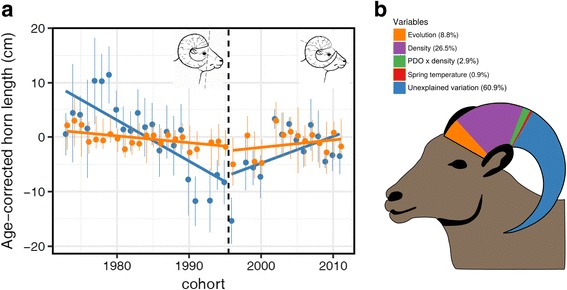Fig. 4.

Evolutionary response to over-exploitation of horn size. A trophy hunted population of bighorn sheep at Ram Mountain, AB, Canada, individually monitored for more than four decades, experienced a decline in horn length, a trait with heritability of 0.36 [34]. a Quantitative genetic analyses revealed that part of this decline was genetically based [33, 34]. For the first 23 years of monitoring, rams could be legally harvested when their horn size achieved four-fifths of a full curl (see drawing top left in a). In 1996, the regulation was changed to a full curl (see drawing top right in a), allowing rams to survive longer into their peak reproductive years before reaching legal size. This change, along with the reduced availability of legal rams, decreased hunting pressure and the genetic decline ceased (panel a modified from [34]). Phenotypic (blue dots and line) and genetic (orange dots and line) estimates of age-corrected horn length of bighorn rams aged 2–4 years declined during the period of high hunting (1973–1995) and slowly recovered under low hunting pressure (1996–2011). This study conservatively suggests that microevolutionary change accounted for 2.62 cm of the observed decline in horn length during the period of high hunting pressure [34]. Douhard et al. [35] showed that approximately 8.8% of the variance in horn length at age 3 is explained by microevolutionary effects, estimated as the mean of the posterior distribution in breeding values for horn length over the entire study period (the variance decomposition is illustrated in proportion to the length of the sheep horn in b). Other major sources of variation illustrated in b include the Pacific decadal oscillation (PDO), a large scale climatic index, population density, and their interaction [35]
